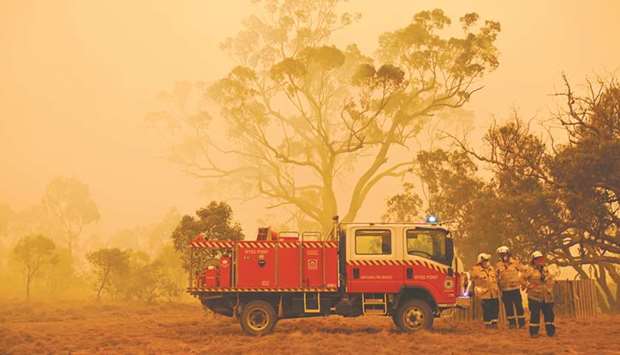The turning point came in 2017, when wind-whipped blazes swept through the foothills, jumped a freeway and burned through thousands of homes and businesses, killing more than 40 people.
The fires in Northern California’s wine country – followed by an even more deadly inferno in Paradise the following year – led many Californians to recognise that climate change was not some distant threat but an immediate catalyst of the state’s ever-more destructive blazes.
Australia is now going through a similar shift in perspective amid fires that have burned more than 30mn acres.
“No one can recall an event like this,” said Nick Clark, a farmer who lost most of his sheep’s pasture to a wind-driven fire on Southern Australia’s Kangaroo Island in mid-January. “And you can say that about a lot of weather events in Australia. It’s hard to say that it’s just a cycle; I think you have to concede that it’s more than just that.”
Australia is a fossil fuel-friendly country, with an economy dependent on tourism and shipping coal to China and other fast-growing Asian nations. In the past, Australians tended to blame fires on natural cycles – wet years, dry years. But now, even in the country’s coal towns, there’s a recognition that something is changing.
“Going back 20 or 30 years, the realisation was there but I don’t think there was the opportunity to engage in the conversation,” said Jon Missen, mine closure and rehabilitation officer for one of Australia’s biggest brown coal-burning power stations, Loy Yang, in the Latrobe Valley, the heart of Victoria’s energy industry.
“Probably 20 years ago, if I said the things I wanted to say that I say now, no one would’ve listened. It’s maybe more of a willingness to discuss, rather than change a view,” he said.
Surveys back up Missen’s assertion.
A January Ipsos poll of more than 1,000 Australians revealed the environment was their top concern, with most drawing a connection between climate change, drought and bushfires.
In November, before some of the country’s biggest fires had erupted, a survey of 1,400 residents by the Australian Institute, a progressive think tank, found two-thirds of participants considered climate change a national emergency. A survey conducted by the Lowy Institute last summer found that 64% of Australians considered climate change a “critical threat” to the country, the highest that number has been since 2006.
The increased concern has even forced Australian Prime Minister Scott Morrison to back away from his denial of prevailing climate change science and state that his government’s views are evolving, though without any specific policy changes.
The prime minister, in a recent interview, also described the increased federal response to bushfires as the “new normal.”
“He started off much too blase about what was going on and, in my opinion, was trying to cover his ... about the climate change issue,” Brisbane resident Meredith Jordan, whose niece’s wedding was disrupted by the bushfires on Kangaroo Island, said of Morrison’s response. “His message should’ve been, ‘Here is our problem now, here is what we are doing with the problem.’ But he kept saying it’s a state issue ... it’s not what we want to hear.”
Compared to Australia, California has long recognised the threats posed by a warming planet, but it wasn’t until the middle of the last decade that the term “new normal” became a talking point for the state’s governors and firefighters. A similar transition is happening on the other side of the globe.
“That’s the $64mn question at the moment – is this the ‘new normal’?” said Ross Bradstock, director of the Center for Environmental Risk Management of Bushfires at the University of Wollongong in New South Wales. “There’s been a lot of politics played out in this, but I think the climate change narrative is paramount.”
To be sure, seasonal wildfires have long shaped the landscapes of both California and Australia, and climate change is hardly the only ingredient in their most recent big blazes. When multiple deadly fires erupted in 2015 in California, destroying more than 3,000 homes and charring some 216,000 acres, the cause for two of them were faulty hot tub wiring and downed power lines.
Power lines also sparked the 2017 Tubbs fire in Northern California’s wine country and the 2018 Camp fire in Paradise, which killed 86 people. Yet scientists say that record-dry weather contributed to the conditions for deadly conflagrations. Prior to the 2017 fires, mean temperatures between April and September across Northern California were the warmest in 123 years. In Australia, 2019 was the country’s warmest and driest year on record.
In both California and Australia, many firefighters sense that the climate has shifted.
Mike Mohler, a Cal Fire spokesman, said his agency is apolitical, “but we can tell you that something is different.”
In Australia, the chief of Victoria’s Country Fire Authority, Steve Warrington, has a similar view.
“It’s not just the length of the season for us, it’s the intensity of the fires,” Warrington said. “So what we found, what we believe is, around the globe we’re getting fires ... in locations we haven’t had before. We’ve seen them in the Arctic Circle, places in Russia that haven’t seen them, places in China. We’re also seeing the fires ... in California, in southeast Australia, where fires are far more intense.”
Weather extremes have whipsawed Australia over the last decade. The years 1997 to 2009 were the driest 13-year period on record in southeastern Australia, according to a report by the country’s Commonwealth Scientific and Industrial Research Organisation. In 2010 and 2011, record rainfall hit the continent, breaking the drought. Then came 2018 and 2019 – Australia’s hottest and driest years on record – followed by the record fires.
The extreme swings have continued in 2020. Over last weekend, Sydney received its heaviest rainfall in roughly 20 years, extinguishing some fires but causing flooding and power outages.
Lightning sparked most of Australia’s recent blazes, yet it is unclear if climate change will directly equate to more lightning-caused fires in the future. A 2016 report from the nonprofit Australian Climate Council said there is not enough data to map out long-term trends, though global patterns would suggest the potential exists.
Given the size and endurance of the bushfires this year, Clark, the Kangaroo Island wool farmer, doesn’t need any more convincing.
“I’m concerned for my kids because that impact is going to be cumulative,” he said. “As more of this sort of thing happens, the more carbon is released into the atmosphere, you know, the more ice caps melt, the whole thing is just ramping up. It’s accelerating the problem.”
Some hope the fires will finally change how Australia addresses both its contribution to climate change and how it adapts.
“I think there’s two conversations. There’s a political conversation – I think we’ve got a lot of denialism in this country about climate change ... and the other kind is the conversation they have around dinner tables and barbecues,” said Greg Noarlunga, a South Australia State Emergency Services worker who was assisting crews on Kangaroo Island last month. “Maybe it’s those internal conversations that will change the direction of this.”
Yet not every person affected by fire shares the level of alarm.
Sheep and cattle farmer Martine Plowman, 42, said she, her husband and their kids review their fire plan before every summer to prepare for scenarios like this. When embers rained on their home and a line of flames approached them from all sides just after the new year, they stood their ground.
The children protected the interior by climbing into the attic with a water gun to extinguish any smoldering embers that blew in through a vent and by patrolling window to window with walkie-talkies, where they announced spot fires in the grass near the home.
Plowman and her husband were outside with buckets, mops and a hose. The family spent hours fending off the fire and ember siege. They lost a few livestock, their shearing shed, and all but 30 of their 2,000 acres was burned. But they and their home survived.
The young family has only had the ranch for seven years, but plan on establishing deep roots in Cobungra. How that future will look in a changing climate isn’t a big concern for them, Plowman said.
“Bushfires are a way of life in this area,” she said. “There’s other people that haven’t been impacted before that now it’s an issue. But that’s always going to be an issue here.”
Australia’s dependence on coal may also be a hard habit to break, said Rae Mackay, Latrobe Valley’s mine rehabilitation commissioner, tasked with helping prepare the region’s mines for eventual decommissioning or new uses.
In 2018, Australia was the world’s largest exporter of coal, earning the country roughly $47 billion in US dollars. It also depends on coal for about 70% of its electricity, making it one of the world’s largest per-capita consumers of fossil fuels.
“Australia has struggled with climatic conditions for a long time,” Mackay said during a recent tour of the Loy Yang power station, which burns the brown coal that’s plentiful in the area. “People are sensitised to it, but they do recognise that they like their cars, they like their energy availability and they like to sell very large amounts of coal to the rest of the world.”
Despite its dependence on fossil fuels, Australia has taken some steps to make its communities more resilient to extreme fires and weather conditions. In 2009, the deadly Black Saturday bushfires prompted the country to update its building codes for new homes in the path of fire and to devise a new strategy for communicating and defending the public.
Some of Australia’s home insurance providers are also refusing to issue new policies or accept claims for a specific period of time, forcing communities to grapple with where they will rebuild or allow new housing.
Yet, like California, Australia has been reluctant to restrict new development in fire-prone areas. “What used to be just farming country with the odd house now is full of people’s homes, which makes it far more challenging from a fire point of view because you have a lot more assets,” said Brian Pritchard, a ranger with the state agency Parks Victoria. – Tribune News Service

Firefighters protecting a property from bushfires burning near the town of Bumbalong south of Canberra.


